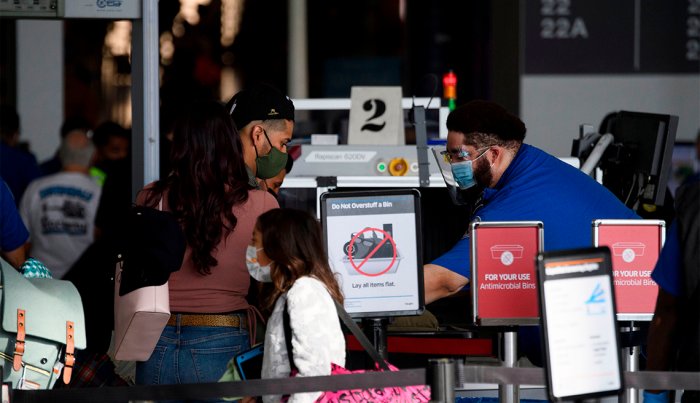
New TSA Security Procedures During the COVID-19 Pandemic
Physical barriers, new tech and rules to prevent infection during airport screenings
The Centers for Disease Control and Prevention (CDC) continues to emphasize that staying home is the best way to protect yourself and others from COVID-19.
The Transportation Security Administration (TSA) continues to implement a range of procedures to keep contact to a minimum for both TSA agents and fliers who go through security screening during the coronavirus outbreak. There’s added urgency to do so, as the number of COVID-19 cases has risen in the U.S., as well as the number of air travelers. More than 946,000 passengers passed through TSA checkpoints on Feb. 14, for example, up from around 90,000 a day in mid-April (though still less than the more than 2.2 million who flew on the same February day last year).
The latest change is a requirement that passengers over the age of 2 wear face masks, with new penalties announced: Those who fail to comply will be prevented from entering the screening area, and “the TSA will recommend a fine ranging from $250 for the first offense up to $1,500 for repeat offenders,” the agency said in a Jan. 31 statement. The order became effective Feb. 2, through at least May 11, 2021.
The TSA also requires officers to don face shields or protective eyewear when their job requires close contact with the public, unless there are acrylic barriers between themselves and passengers (the TSA has installed nearly 7,000 of the barriers at airports around the country). The agency has also embraced new technology that prevents agents from having to touch bags: It’s installed more than 300 computed tomography (CT) units, able to offer detailed 3-D images of a carry-on bag’s contents.
The TSA said in a recent statement that even as COVID-19 vaccines become available for agents in the next few weeks or months, these infection-prevention procedures will stay in place.
More than 6,100 TSA employees have tested positive for COVID-19, and 14 have died as a result of contracting the coronavirus.
The current safety measures — part of the TSA’s “Stay Healthy, Stay Secure” campaign — include:
1. To avoid cross-contamination, TSA officials no longer handle boarding passes. Passengers place their paper or electronic passes on the code reader and hold it for the officer to inspect. The agent may ask you to briefly lower your mask to confirm your identity.
2. Food needs to be placed in a clear plastic bag and taken out of other bags before being put into a bin for inspection. The TSA explains: “Food items often trigger an alarm during the screening process; separating the food from the carry-on bag lessens the likelihood that a TSA officer will need to open the carry-on bag and remove the food items for a closer inspection.”
3. Travelers are asked to be extra vigilant about prohibited items. The TSA has long limited liquids to 3.4 ounces, and the agency says it’s even more important to follow this guideline now so that officers can “touch the contents inside a carry-on bag much less frequently.” If there are prohibited items, passengers may be asked to remove them and return through security after throwing them out. Up to 12 ounces of hand sanitizer will be permitted through security, but the TSA asks that it be removed from carry-on bags before screening.
4. Passengers need to practice physical distancing whenever possible. Floor markers indicate appropriate spacing between those waiting in line, and many reminders are posted.
5. TSA officers at checkpoints must wear face masks and gloves (and eye protection when close contact is necessary), and there’s a new federal order for the TSA to require that travelers wear masks during airport screening (as noted above). Face shields aren’t considered a suitable substitute, though they can be used in addition to masks. Officers are also required to change gloves after each pat-down search of a passenger.
6. Travelers should put loose items into carry-on bags rather than into bins. Keeping objects such as keys and phones out of the bins will “reduce touch-points during the screening process,” according to the TSA.
7. Passengers should arrive at airports with plenty of time for screening. They are encouraged to sign up for TSA PreCheck, which allows for speedier passage through screening (you don’t need to take off your shoes and belts and can leave liquids and laptops in your carry-on).
8. The TSA will accept driver’s licenses or state-issued IDs a year after expiration. But travelers should be aware that enforcement of the Real ID law begins Oct. 1.
If you have any questions about the procedures, you can call the TSA’s customer service center at 866-289-9673, or get in touch through Twitter (@AskTSA) or Ask TSA on Facebook.
Editor’s note: This article was originally published on May 21, 2020. It’s been updated to reflect new TSA procedures.
Posted from AARP



